Astronomers have found clumps of dark matter 30,000 light-years wide in the space between galaxies in the distant universe.
A team of Japanese astronomers has used the Atacama Large Millimeter/submillimeter Array (ALMA) to map the distribution of dark matter on an unprecedentedly small scale. Their findings back up the idea that dark matter particles are “cold,” that is, slow-moving with respect to the speed of light. The find is an important step on the road towards understanding the nature of these particles.

NAOJ / K.T. Inoue
The mystery of dark matter has confounded astronomers for close to a century, ever since Fritz Zwicky first suggested its existence in the 1930s. There are multiple places in the universe, whether in the outskirts of individual galaxies, or within clusters of galaxies, where there seems to be more gravity at work than meets the eye. One possible explanation is that there is an invisible gravitational glue — dark matter — hidden away out of sight.
Now, a team led by Kaiki Taro Inoue (Kindai University, Japan) has made inroads by using ALMA to observe a distant quasar called MG J0414+0534, which is situated 11 billion light-years away from Earth. The team's findings are published in the Astrophysical Journal.
Inoue's team observed a nearer, foreground galaxy bending the quasar's light, which created four separate images of the quasar. This effect is known as gravitational lensing. However, the positions and shapes of the quartet of lensed images don't match up with predictions based on the gravitational pull of the foreground galaxy alone.
By using ALMA, an array of 66 radio antennae in the Chilean Atacama Desert, Inoue's team got an unprecedentedly precise look at what's going on. “Our measurements have at least 10 times better resolution than previous measurements,” Inoue says.
The team concluded that clumps of dark matter residing in intergalactic space, rather than just those in the lensing galaxy, further skewed the quasar’s light en route to Earth. That’s why the images didn't match up. The clumps are about 1.1 arcsecond across on the sky; if the clumps are near the foreground galaxy, that corresponds to 30,000 light-years across. If true, this marks the first time that the distribution of dark matter has been mapped on such a small scale.

ALMA (ESO / NAOJ / NRAO) / K.T. Inoue et al.
What's more, the team says, the lensing effect of these line-of-sight structures is consistent with cold dark matter models. Candidates for dark matter's true nature usually fall into two broad groups. If dark matter is made of heavy, slow-moving particles, it is referred to as “cold.” Possibilities include axions or weakly interacting massive particles (WIMPs). By contrast, “hot” dark matter particles would be light and considerably faster. Ghostly neutrinos are one potential hot dark matter candidate.
“The work appears to be very thorough,” says Kyle Oman (University of Durham, UK), who was not involved in the research. “It adds a little bit more weight to an already well-established cosmological model.” That model, which incorporates cold dark matter, describes these dark particles helped draw the first galaxies and clusters of galaxies together. Without this astronomical adhesive, the universe would be a far more barren and far less interesting place. However, so far, all searches for theoretical cold dark matter have come up empty.
That has led some to turn to an alternative model, known as modified gravity. In this scenario, there only appears to be missing mass; instead, gravity itself is variable. According to Hongsheng Zhao (University of St. Andrews, UK), who was also not involved in the research, the mismatched lensed quasar images “could also be explained by line-of-sight dwarf galaxies [and] modified gravity, which the present data do not exclude.”
For their part, Inoue's team are currently making further observations in the hope of adding more data to the gravitational lensing model. “We have an ongoing project, in which we will observe several gravitationally lensed quasars using ALMA,” he says. “The additional observations will reveal dark matter clumps residing in intergalactic space.”
Taken together, these results — both present and future — could prove an important piece of the dark matter puzzle and point astronomers towards the answer to one of the biggest riddles in modern cosmology.
 0
0









Comments
You must be logged in to post a comment.